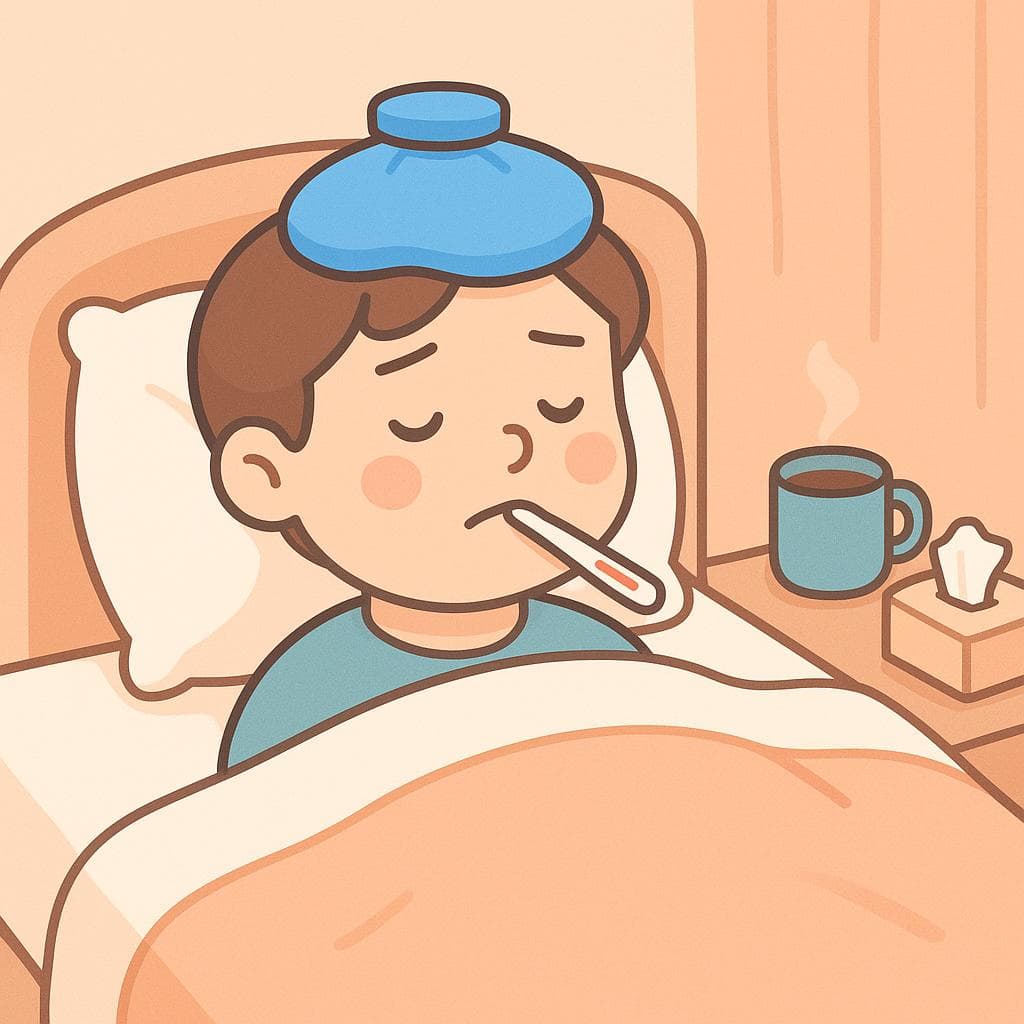I have a fever
in SpanishTengo fiebre
/TEHN-goh FYEH-breh/
The standard, most common way to say you have a fever in any Spanish-speaking country. It literally translates to 'I have fever'.

When you have a temperature, you say 'Tengo fiebre' (I have a fever).
💬Other Ways to Say It
Tengo calentura
/TEHN-goh kah-len-TOO-rah/
A very common way to say 'I have a fever' in Mexico and parts of Central/South America. However, use with caution: in other regions, 'calentura' can mean sexual arousal.
Estoy con fiebre
/ehs-TOY kohn FYEH-breh/
Literally 'I am with fever.' It emphasizes your current state or condition right now.
Tengo temperatura
/TEHN-goh tem-peh-rah-TOO-rah/
Literally 'I have temperature.' While everyone has a body temperature, this is used euphemistically to mean a *high* temperature.
Tengo unas décimas
/TEHN-goh OO-nas DEH-see-mas/
Refers to 'tenths' of a degree. Used when you have a low-grade fever (e.g., 37.2°C to 37.5°C) but not a full-blown high fever.
Me siento afiebrado
/meh SYEN-toh ah-fyeh-BRAH-doh/
Means 'I feel feverish.' Used when you haven't measured your temperature yet but feel the symptoms.
Estoy ardiendo
/ehs-TOY ar-DYEN-doh/
Literally 'I am burning.' Used to express a very high fever where you feel extremely hot.
🔑Key Words
Key Words to learn:
📊Quick Comparison
Depending on where you are and how sick you feel, choose the right expression.
| Phrase | Formality | Best For | Avoid When |
|---|---|---|---|
| Tengo fiebre | Neutral | Any situation (Universal) | Never (it's always correct) |
| Tengo calentura | Informal | Mexico & Central America | In Spain/South America (sexual connotation) |
| Tengo unas décimas | Neutral | Spain/Southern Cone (Low fever) | You have a very high fever |
📈Difficulty Level
The 'ie' in 'fiebre' (FYEH-breh) is a diphthong that can be tricky, but otherwise straightforward.
Requires remembering to use 'Tener' (to have) instead of 'To be', but the structure is simple.
Regional slang (calentura) and the 'Estoy caliente' mistake create some cultural pitfalls.
Key Challenges:
- Remembering not to say 'Estoy caliente'
- Pronouncing the soft 'r' in fiebre
💡Examples in Action
No puedo ir a trabajar hoy, tengo fiebre.
I can't go to work today, I have a fever.
Creo que el bebé tiene calentura.
I think the baby has a fever.
Me siento mal, parece que tengo unas décimas.
I feel bad, it seems like I have a slight fever.
¡Estás ardiendo! Necesitamos un termómetro.
You're burning up! We need a thermometer.
El paciente presenta fiebre alta y dolor de cabeza.
The patient presents high fever and headache.
🌍Cultural Context
The 'Calentura' Trap
In Mexico and parts of Central America, 'tengo calentura' is the standard way to say 'I have a fever.' However, in many other countries (like Argentina or Spain), 'calentura' is slang for sexual arousal (horniness). If you are traveling outside of Mexico, stick to 'tengo fiebre' to avoid an awkward mix-up!
Celsius vs. Fahrenheit
Spanish-speaking countries use Celsius. If you say you have a temperature of '100' (Fahrenheit), they will think you are boiling alive! A fever usually starts at 38°C. Anything between 37°C and 38°C is often called 'unas décimas' (a few tenths) or 'febrícula'.
The Magic of VapoRub
In many Latino households, having a fever or cold often leads to one universal cure: Vicks VapoRub (often just called 'Vick' or 'Vivaporú'). It's culturally seen as a miracle cure applied to the chest, feet, or nose, regardless of what the doctor might prescribe.
❌ Common Pitfalls
Using 'Estoy caliente' instead of 'Tengo fiebre'
Mistake: "Saying 'Estoy caliente' to mean you feel hot from a fever."
Correction: Tengo calor (I feel hot due to weather) OR Tengo fiebre (I have a fever).
Using 'Ser' instead of 'Tener'
Mistake: "Saying 'Soy fiebre' or 'Estoy fiebre'."
Correction: Tengo fiebre.
💡Pro Tips
The Hand-Forehead Gesture
Just like in English-speaking cultures, placing the back of your hand on someone's forehead is the universal non-verbal sign for checking for a fever. You can accompany this by asking, '¿Te sientes mal?' (Do you feel bad?).
Describing Severity
To be more specific, you can say 'tengo fiebre alta' (high fever) or 'tengo fiebre leve' (mild fever). If it's just a little bit, use 'tengo un poco de fiebre'.
🗺️Regional Variations
Mexico & Central America
It is extremely common to hear 'calentura' here without any sexual connotation in a medical context, unlike almost everywhere else.
Spain
Spaniards are very specific about low-grade fevers, often referring to them as 'décimas' rather than full 'fiebre'.
Southern Cone (Argentina/Uruguay/Chile)
Very standard usage of 'fiebre'. 'Calentura' is exclusively slang for anger or lust here.
💬What Comes Next?
Someone tells you they have a fever
Tengo fiebre.
I have a fever.
¡Pobrecito! ¿Te tomaste la temperatura?
Poor thing! Did you take your temperature?
Offering help to someone with a fever
Me siento muy mal.
I feel very bad.
¿Quieres que te traiga una pastilla?
Do you want me to bring you a pill/medicine?
🔄How It Differs from English
The biggest difference is the verb choice. In English, you can say 'I am feverish' (adjective) or 'I have a fever' (noun). In Spanish, the standard is almost exclusively 'Tener' (to have) + Noun. Also, Spanish speakers distinguish heavily between a full fever and 'décimas' (a slight rise in temperature).
False Friends & Common Confusions:
Why it's different: Translating this literally as 'Estoy caliente' usually means 'I am horny' in Spanish.
Use instead: Use 'Tengo calor' (I feel hot from weather) or 'Tengo fiebre' (I have a fever).
🎯Your Learning Path
➡️ Learn Next:
How to say my head hurts
Headaches almost always accompany fevers, so it's a natural next phrase.
How to say I need a doctor
Crucial vocabulary if the fever gets worse.
How to say get well soon
So you can respond politely when someone else tells you they have a fever.
✏️Test Your Knowledge
💡 Quick Quiz: I have a fever
Question 1 of 3
You are in Madrid, Spain, and you feel slightly warm but not terrible (around 37.3°C). What is the most natural thing to say?
Frequently Asked Questions
Can I say 'Soy fiebre'?
No, never. 'Soy' comes from the verb 'Ser' (to be). You cannot 'be' a fever. You must use the verb 'Tener' (to have) -> 'Tengo fiebre'.
Is 'calentura' a bad word?
It depends on the region. In Mexico, it is a normal medical word for fever. In Spain and South America, it is slang for sexual excitement. It's safest to use 'fiebre' if you are unsure.
How do I say 'I have a high fever'?
You can say 'Tengo fiebre alta' or 'Tengo mucha fiebre'. If it is extremely high, you can say 'Estoy ardiendo' (I am burning up).
Do Spanish speakers use Fahrenheit or Celsius?
They use Celsius. A fever is generally considered 38°C or higher. Normal body temperature is around 36.5°C - 37°C.
📚Continue Learning Spanish Phrases
Explore More Phrases in These Categories
Find similar phrases to expand your Spanish vocabulary:
Want to Learn More Spanish Phrases?
Browse our complete collection of Spanish phrases organized by situation, from basic greetings to advanced conversations. Perfect for travelers, students, and anyone learning Spanish.
View All Spanish Phrases →